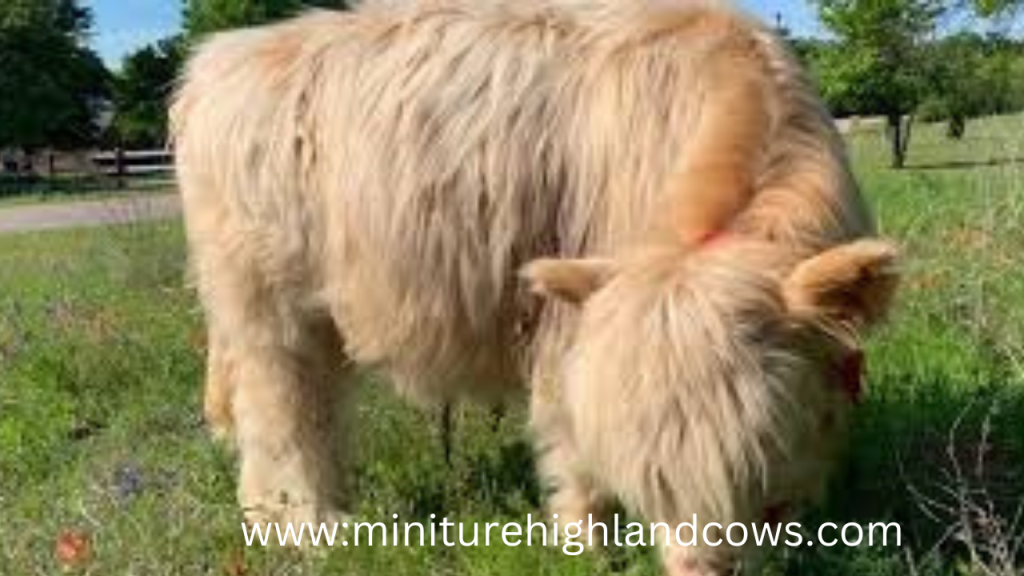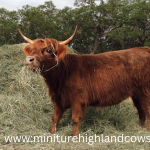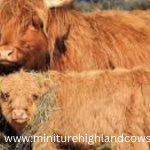Miniature Highland cows are smaller versions of the classic Highland cattle. They carry long, shaggy coats and have unique horns. Miniature Highland cows, although smaller, serve for most of the same purposes that full-sized Highland cows are sought after for, with a few added advantages because of their size. Some common uses include the following:
Micro Mini Highland cow
Micro Mini Highland Cows: A Deeper Dive
While there is no denying the cute appeal of a small, cute Highland cow, there needs to be some clarification over here. The term “Micro Mini Highland Cow” does not exist in real strict terms.

We’re really talking about Miniature Highland Cows.
These are smaller versions of the traditional Highland breed bred over generations to maintain its signature look while reducing size.
- Smaller Stature: They are significantly smaller than their full-sized counterparts, with a height of 36-42 inches at the shoulder.
- Fluffy Coat: They retain the iconic long, shaggy coat that protects them from harsh weather conditions.
- Friendly Temperament: Like their larger relatives, they are known for their docile and gentle nature, making them great pets or show animals.
- Low Maintenance: They are relatively smaller and thus require fewer feeds and space, making them suitable for smaller properties.
Why are they so popular?
- Cute Appearance: They are so cute with their compact size and fluffy coat.
- Distinct Character: They have a special character and charm.
- Versatility: They can be kept as pets, show animals, or even for small-scale beef production.
- Low-Impact Lifestyle: Their smaller size and grazing habits make them environmentally friendly.
Important Considerations:
While Miniature Highland Cows are wonderful animals, it’s crucial to do thorough research before bringing one into your life. Consider factors like:
- Initial Cost: Miniature Highland cows can be quite expensive, especially pedigree animals.
- Ongoing Costs: Factor in costs for feed, shelter, veterinary care, and potential breeding expenses.
- Space Needs: As they are smaller than other full-sized cows, they still need proper space for grazing and exercise.
- Legal and Zoning Laws: You should ensure that you do not violate zoning laws or local regulations regarding livestock ownership.
In summary, Miniature Highland Cows are lovely creatures, offering a perfect combination of beauty, personality, and practicality. If you think about getting one, then be prepared for a long-term commitment and lots of cuddles!
[Picture of Miniature Highland Cow]
Would you like to know more about caring for a Miniature Highland Cow or perhaps other unique breeds of livestock?
1. Meat Production
- Highland cattle produce high-quality, lean, and flavored beef. Since the miniature version of Highlands is smaller in size, their meat yield will still be smaller, but their meat is tender, low in fat, and considered a delicacy.
- Show Animals
- Miniature Highland cattle are popular in agricultural shows because of their good looks and gentle nature. Being smaller, they are easier to care for and show in competitions as opposed to the full-sized cows.
10 interesting facts about highland cows
Here are 10 interesting facts about Highland cows, their uniqueness, and charm:

1. Oldest Registered Breed
Highland cows are one of the oldest cattle breeds in the world, records trace back to the 6th century. The Highland Cattle Society, established in 1884, is the oldest cattle registry.
2. Dual Coat for Harsh Climates
- They have a special double coat: a long, coarse outer layer to guard against wind and rain, and a soft undercoat for insulation. This makes them exceptionally hardy, thriving in cold, wet, and windy climates.
3. Friendly and Docile Temperament
- Despite their intimidating horns, Highland cows are known for being friendly, calm, and docile. They are often called “gentle giants.”
4. Iconic Appearance
- Their long, shaggy hair and sweeping horns make them one of the most distinguishable breeds of cattle. Their image has made them an iconic symbol of Scotland.
5. Low Maintenance
- Highland cows are very robust and need little care. They can graze on tough ground and eat vegetation that other cattle would turn down, so they are perfect for sustainable farming.
*6. Healthy Beef
- Highland beef is lean and low in cholesterol but full of flavor and nutrients. They contain less fat as they can keep warm with their heavy coat rather than excessive body fat.
7. Conservation Grazing Experts
- Highland cattle are used largely in conservation works to clear dense vegetation, restore habitats, and control invasive plant growth, which in turn maintains biodiversity in areas.
8. Lifespan and Longevity
- Highland cows tend to live longer than most other breeds of cattle, living for an average of 15–20 years. They also breed well later in life, which is unusual for most cattle.
9. Wide Horn Variations
- Both the males and females have horns, but the shape of them does vary:
- Males: Thicker, horizontal horns with a gentle upward curve.
- Females: Slightly thinner and more delicate horns that curve outward.
10. Miniature Variants
- Miniature Highland cows are gaining popularity for small-scale farms and as pets. They retain all the charm and characteristics of their larger counterparts but are more manageable in size.
Highland cows are not only practical for farming and land management but also loved because of their beauty and gentle nature, making them a favorite among farmers, tourists, and animal lovers.
Mini Highland cow milk production
They can lactate, but of course, the milk production is a far cry from the ordinary dairy cows like Holsteins or Jerseys. Highland Cattle are bred and valued for their resilience and meat more than anything else. Here’s what to expect:

Milk Production in Mini Highland Cows
- Amount of Milk:
- Miniature Highland cows produce 1-3 gallons of milk per day under optimal conditions. Again, much less than pure dairy breeds which can produce 6-10 gallons daily.
- Milk Quality:
- Highland cow’s milk is rich and creamy. It contains around 4–5% butterfat, which makes it perfect for butter production, cheese-making, or other diary processing; however, in small quantity.
- Milking Suitability
- Mini Highland cows are not often bred for big production milking, hence some hard work needs to be put into the practice of letting them get milked regularly.
- Their temperament tends to be mild, but handling and milking them might require patience and persistence, especially if they have not been accustomed to milking at all.
Factors to Consider Before Milking Mini Highlands
- Time and Effort: Being non-natural dairy cows, milking them may take much time and require gentle handling.
- Purpose: Their milk production is usually sufficient for personal use on a small farm or homestead but not suitable for commercial dairy operations.
- Feeding and Care: To maximize milk production, the cow should have a balanced diet and good care, including proper grazing or high-quality hay and supplemental feeds if necessary.
Keeping a miniature Highland cow for milk can be a fulfilling hobby, especially if you enjoy rich, creamy milk in small amounts. It’s really suitable for those who appreciate them for their charm and versatility and not for high milk yield.
3. **Pet or Companion
- Because of their friendly nature and manageable size, miniature Highland cows are sometimes kept as pets or companions on small farms or hobby farms. They can be a good fit for people with limited space who want a unique and interactive farm animal.
**4. **Land Management (Grazing)
- Miniature Highlands are excellent grazers, similar to full-sized Highland cows, and can be used to control overgrown grass or land. Their hardiness makes them suitable for a wide range of environments, even harsher ones. They are often used for sustainable land management or to control vegetation in smaller areas.
5. Breeding Stock
- Miniature Highland cows are occasionally bred to breed more compact cattle for the individual wanting Highland traits without the need for lots of space. They are also used to crossbreed with other breeds of cattle to acquire certain desired qualities.
6. Ornamental or Hobby Farming
- Because of their cute appearance, small Highland cows are sometimes kept just for decorative purposes or even on hobby farms where they can attract visitors by adding to the landscapes’ beauty and charm.
Miniature Highland cows thus are a very versatile breed, appreciated for their calm disposition, beautiful appearance, and use in commercial as well as hobby farming.
FAQ: What are Miniature Highland Cows Used For?
Miniature Highland cows are popular because of their small size, but also because they can be useful in multiple ways. Here are the main uses for the miniature highland:
1. Meat Production
- Miniature Highland cows are bred for lean, flavorful beef, much like their full-sized counterparts.
- While they produce less meat due to their size, the quality is excellent, with a rich taste and low fat content.
2. Pets and Companions
- Their gentle nature and manageable size make them ideal as pets or companions on hobby farms.
- They are especially popular among families and small-scale farmers looking for unique, interactive animals.
3. Show Animals
- Mini Highland cows’ spectacular appearance makes them a showstopper in agricultural shows and competitions. .
- Their smaller size and docile nature make them ideal for competitions as well.
Above is some of the information about mini Highlands cow.
4. Land Management
- Just like full-sized Highlands, miniatures are good grazers, helping to control overgrowth
- They are suitable for sustainable land management of smaller properties or for brush clearing unwanted.
5. Breeding Stock
- Miniature Highland cows are an asset in breeding programs that can produce the compact, hardy cattle adapted to smaller farms. .
- They possess the Highland breed’s resilience and adaptability. .
6. Ornamental Farming
- Many people keep Miniature Highland cows for their charming, photogenic look. .
- They are a beautiful ornament for hobby farms and properties, often serving as attractions for visitors. .
7. Tourism and Photography
- Miniature Highlands are a common feature of the landscape in village tourism and photography due to their cute, individuality.
8. Small Dairy
- While not bred for dairy, Miniature Highland can produce tiny quantities of rich milk which can be sufficient for personal use like making butter or cheese.
Miniature Highlands are versatile. They combine practicality with charm and represent a perfect choice for farmers, animal lovers, and hobbyists.










